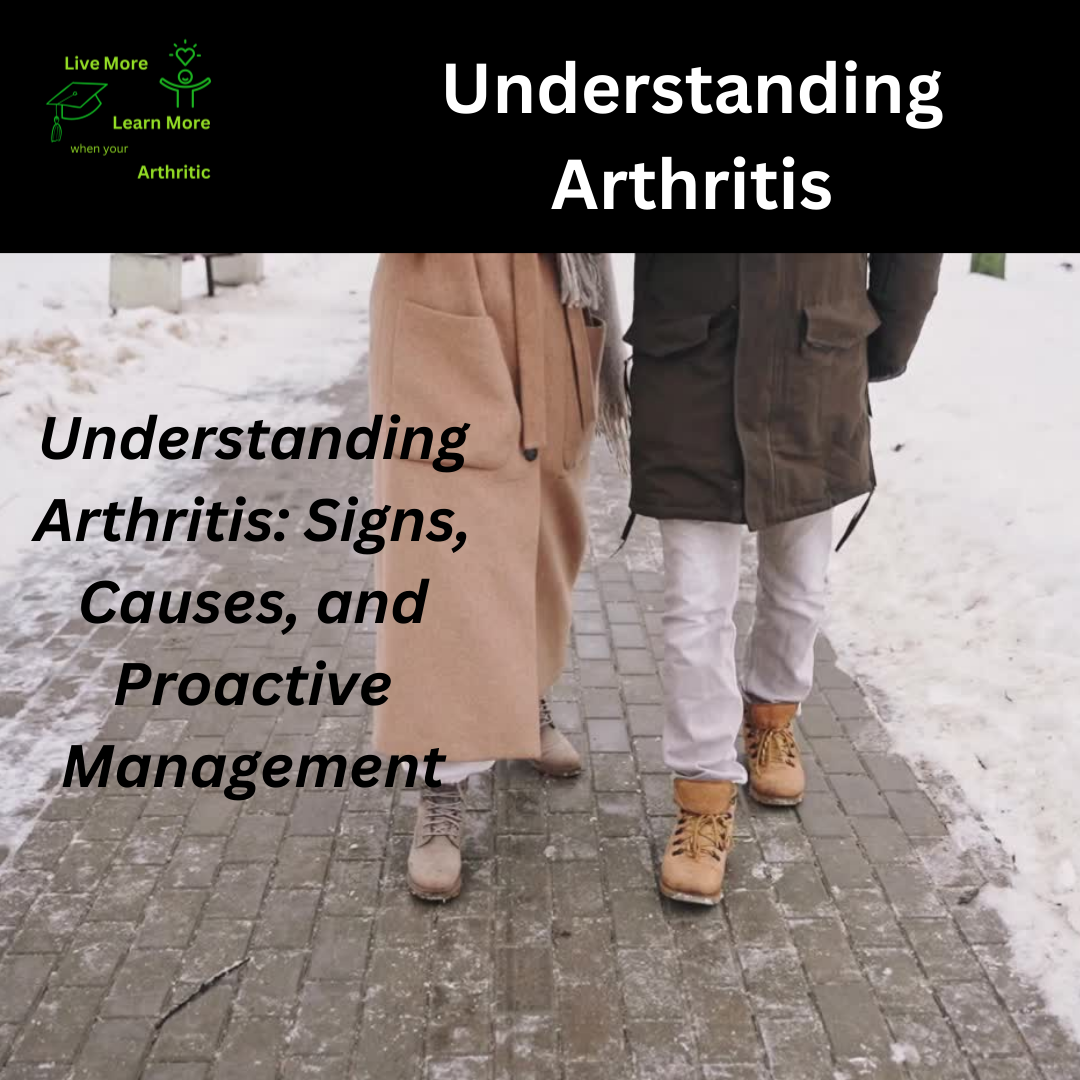
Understanding Arthritis
Arthritis affects millions of people worldwide, and its impact extends far beyond physical discomfort. This chronic condition can diminish one’s quality of life, but with awareness and proactive measures, individuals can find relief and maintain a fulfilling lifestyle.
 What are the Outward Signs of Arthritis?
What are the Outward Signs of Arthritis?
Arthritis manifests through various outward signs, including:
- Joint Pain and Stiffness: Persistent discomfort and limited mobility in joints, particularly after periods of rest or activity. This pain often increases with movement and may be relieved with rest.
- Swelling and Redness: Inflamed joints may appear swollen, warm, and red, indicating underlying inflammation.
- Joint Deformities: Over time, arthritis can cause joint deformities, altering the shape and function of affected areas. This is often due to prolonged inflammation and joint damage.
- Limited Range of Motion: Difficulty moving joints through their full range of motion due to stiffness and pain, which can significantly impact daily activities.
Is Arthritis Related to Weight Gain?
Excess weight can indeed exacerbate arthritis symptoms, particularly in weight-bearing joints like the knees and hips. Increased body weight puts added stress on joints, contributing to inflammation and accelerated joint degeneration. Maintaining a healthy weight through diet and exercise can significantly alleviate symptoms and slow the progression of arthritis.
Types of Arthritis and Their Causes
Arthritis encompasses several types, each with distinct causes:
- Osteoarthritis (OA): Resulting from wear and tear on joints over time, often due to aging, obesity, joint injuries, or genetic factors. OA primarily affects the cartilage, causing it to break down and leading to pain and stiffness.
- Rheumatoid Arthritis (RA): An autoimmune disorder where the body’s immune system attacks joint tissues, causing inflammation and joint damage. RA can affect multiple joints and often leads to severe pain and deformities.
- Psoriatic Arthritis: Linked to psoriasis, this condition affects joints and causes skin lesions. It often leads to swelling, stiffness, and pain in the joints.
- Gout: Caused by the buildup of uric acid crystals in the joints, leading to sudden, severe pain and inflammation. Gout attacks can be extremely painful and typically affect the big toe.
- Ankylosing Spondylitis: Primarily affecting the spine, causing stiffness and pain. This type of arthritis can lead to the fusion of spinal vertebrae, resulting in reduced flexibility and a hunched posture.
How Does Arthritis Start and Progress?
Arthritis can start subtly, with mild discomfort and stiffness that worsens over time. Cartilage breakdown, inflammation, and joint damage characterize its progression. Early symptoms may include occasional pain and stiffness, progressing to persistent discomfort and joint deformities in advanced stages. Identifying and managing symptoms early is crucial for slowing the disease’s progression.
Identifying Arthritis: Signs and Symptoms
You can identify arthritis through:
- Joint Pain: Chronic pain in joints, worsened by movement or rest. The pain can vary in intensity and may be accompanied by a burning sensation.
- Swelling and Warmth: Inflamed joints feel swollen, warm, and tender. This is a sign of underlying inflammation and possible joint damage.
- Morning Stiffness: Difficulty moving joints after waking up, which can last for several minutes to hours.
- Fatigue: Persistent tiredness due to ongoing inflammation. Fatigue is a common symptom that can affect overall energy levels and well-being.
Interconnected Nature of Arthritis
Arthritis isn’t isolated; it often coexists with other health conditions like cardiovascular disease, diabetes, and obesity. Chronic inflammation in arthritis contributes to systemic health issues, emphasizing the need for holistic management. Addressing these interconnected conditions can improve overall health outcomes and quality of life.
Preventative Actions and Benefits
Taking proactive steps can mitigate arthritis impact and improve quality of life:
- Maintain a Healthy Weight: Reducing excess weight alleviates joint stress, particularly in weight-bearing joints like the knees and hips.
- Regular Exercise: Strengthen muscles around joints to support and protect them. Low-impact exercises like swimming, cycling, and walking are particularly beneficial.
- Balanced Diet: Incorporate anti-inflammatory foods like fruits, vegetables, and omega-3 fatty acids. A diet rich in antioxidants can help reduce inflammation and improve overall health.
- Joint Protection: Avoid overexertion and repetitive stress on joints. Using assistive devices and practicing good posture can help prevent joint damage.
- Medical Monitoring: Regular check-ups and monitoring can catch early signs of arthritis. Early intervention can prevent severe damage and improve treatment outcomes.
Benefits of Regular Preventative Actions
Adopting preventive measures can:
- Reduce Pain and Stiffness: Enhance joint function and reduce discomfort. Consistent exercise and weight management can significantly alleviate symptoms.
- Enhance Mobility: Improve range of motion and flexibility, making daily activities easier and less painful.
- Slow Disease Progression: Minimize joint damage and deformities, preserving joint function and quality of life.
- Boost Overall Health: Reduce risk factors associated with arthritis-related comorbidities. A holistic approach to health can improve physical and mental well-being.
Achieving a Higher Quality of Life
A proactive approach to arthritis management is essential for optimizing quality of life. By addressing symptoms early and adopting healthy habits, individuals can enjoy improved mobility, reduced pain, and enhanced overall well-being. Support from healthcare professionals, family, and support groups can also play a vital role in managing arthritis effectively.
Possible Complications of Arthritis
Unmanaged arthritis can lead to:
- Joint Deformities: Irreversible changes to joint structure, resulting in altered function and appearance.
- Disability: Impaired mobility and reduced independence, affecting the ability to perform daily tasks.
- Chronic Pain: Persistent discomfort affecting daily activities, which can lead to a decreased quality of life.
- Emotional Impact: Depression and anxiety due to chronic pain and limitations. Psychological support and pain management strategies are essential components of comprehensive arthritis care.
In conclusion, understanding arthritis, its signs, causes, and management strategies is crucial for those affected by this chronic condition. With proactive measures and lifestyle adjustments, individuals can mitigate its impact, fostering a healthier and more fulfilling life despite arthritis’s challenges.
- Mayo Clinic. “Arthritis.” Accessed June 18, 2024. https://www.mayoclinic.org/diseases-conditions/arthritis/symptoms-causes/syc-20350772
- Arthritis Foundation. “What is Arthritis?” Accessed June 18, 2024. https://www.arthritis.org/diseases/
- National Institute of Arthritis and Musculoskeletal and Skin Diseases (NIAMS). “Arthritis Information.” Accessed June 18, 2024. https://www.niams.nih.gov/health-topics/arthritis
- WebMD. “Types of Arthritis.” Accessed June 18, 2024. https://www.webmd.com/arthritis/default.htm
- Centers for Disease Control and Prevention (CDC). “Arthritis.” Accessed June 18, 2024. https://www.cdc.gov/arthritis/index.htm
